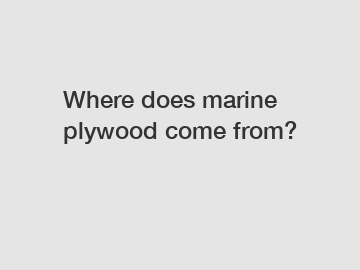Where does marine plywood come from?
Where Does Marine Plywood Come From?
Marine plywood is a type of plywood that is specifically designed for use in marine environments. It is known for its exceptional durability and resistance to water, making it the ideal choice for applications such as boat construction and other maritime projects. But have you ever wondered where marine plywood actually comes from? In this article, we will explore the origins of marine plywood and uncover the process behind its production.
1. The Origins of Marine Plywood.

Marine plywood finds its roots in the early 20th century, as boat builders sought a material that could withstand the harsh conditions of the sea. Traditional plywood, while versatile and widely available, was not suitable for marine use due to its tendency to warp and deteriorate when exposed to moisture over time. As a solution, marine plywood was developed as a specialized type of plywood that could resist water damage and offer long-lasting performance even in the harshest of marine environments.
2. The Raw Materials.
To produce marine plywood, manufacturers start with the same raw materials used for traditional plywood - thin layers of wood veneer. However, the key difference lies in the type of wood selected for marine plywood production. Typically, hardwoods such as meranti, birch, or spruce are chosen for their durability and water-resistant properties. These woods are carefully sourced from sustainable forests to ensure environmental responsibility.
3. The Manufacturing Process.
The production of marine plywood involves several steps. First, the selected hardwood veneers are rotary-cut or sliced to the desired thickness. Then, the veneers are layered and glued together using specialized marine-grade adhesives that provide maximum water resistance. After the layers are glued, the plywood is pressed under high pressure and heat to ensure a strong bond between the layers. This process, known as hot-pressing, helps to create a robust and structurally sound sheet of marine plywood.
4. The Grading System.
Marine plywood is subject to a grading system that determines its quality and suitability for different applications. The most well-known grading system used for marine plywood is the "British Standard BS 1088." This standard ensures that marine plywood meets specific requirements regarding veneer quality, adhesive performance, and overall durability. Plywood that meets these rigorous standards is marked with the "BS 1088" label, guaranteeing its suitability for marine use.
5. Manufacturers and Suppliers.
Today, marine plywood is produced by several reputable manufacturers and suppliers worldwide. These companies specialize in the production of marine-grade plywood and have established themselves as leaders in the industry. They ensure that the marine plywood they produce adheres to the highest quality standards and is suitable for a wide range of marine applications.
Closing Paragraph:
In conclusion, marine plywood is a specialized type of plywood that is specifically designed for marine applications. Its origins can be traced back to the early 20th century when the need for a water-resistant plywood became apparent. Through sourcing durable hardwoods, implementing a careful manufacturing process, and adhering to strict grading systems, marine plywood has become the go-to material for boat builders and maritime projects. If you are in need of high-quality marine plywood, don't hesitate to contact us. Our team of experts will be happy to assist you with your requirements.
For more information, please visit High Quality Bending Plywood, Hardwood plywood for shelving, Bleached poplar plywood for cabinets.

Comments